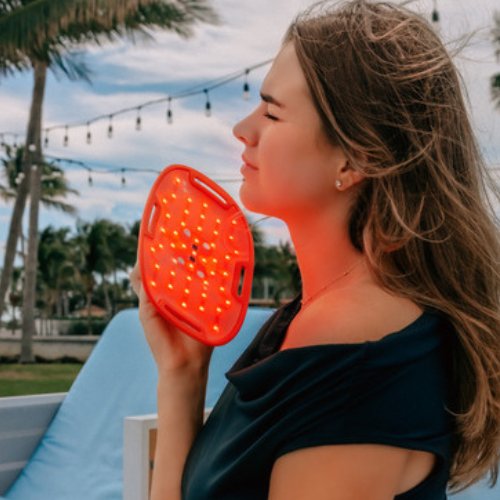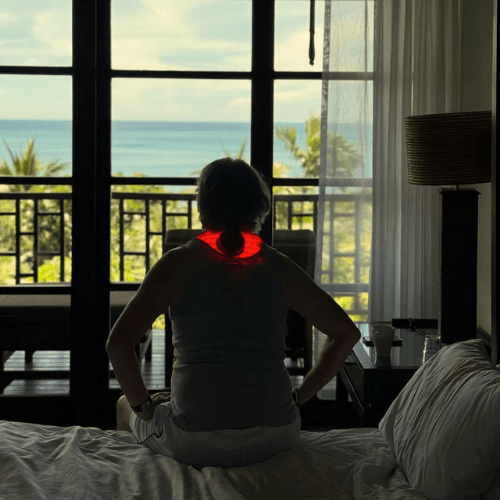Red Light Therapy for Head Health: Daily Routine Tips and Tricks
Welcome to the world of red light therapy, where head health meets new technology. Red light therapy is a healing type that utilizes specific wavelengths of light to promote well-being. What does red light therapy for the head do for you? Whether you are trying to reduce headaches, improve sleep quality, or clear your mind, red light therapy can become your new best friend. So, let's get into this bright topic and learn how to integrate it into our lives.
Table of content
What is Red Light Therapy?

Red light therapy (RLT) is a therapeutic technique that uses low-level wavelengths of red light. RLT exposure heals and rejuvenates the skin since it penetrates its tissues. But just how does it work? The process is like photosynthesis in plants—specific wavelengths of light are absorbed to accelerate healing processes. It enhances circulation in the cells of RLT, increases collagen production, and brings down oxidative stress, thereby improving head health.
Red light therapy is preferable as an alternative treatment since it is not painful and is not invasive. Many use Lumaflex devices since they ensure that red light is harmless without such harmful effects.
Comparison with Other Light Therapies
When it comes to light therapies, you have the whole spectrum. Red light therapy is only one of many, including blue, UV, and even green light options. Let's take a quick peek at how they compare.
Blue light therapy is widely used to treat acne or reverse the effects of seasonal affective disorder (SAD). Blue light is known to have antibacterial properties; however, unlike RLT, it does not penetrate deep into the skin or tissues.
UV light therapy assists in dermatology for psoriasis or eczema. However, it's not favored currently due to risks like premature skin aging or cancers after a period of exposure.
Green light therapy is mainly researched for reducing hyperpigmentation or melasma, as it strikes a different chord than what red light tries to achieve.
All the above, red light therapy is a favorite for its holistic effects on healing, rejuvenation, and mood elevation without imposing harsh skin or health effects.
Red Light Therapy Daily Routine Integration

Morning Red Light Therapy Practices
Wake up to a touch of red light therapy and begin the day! Add some minutes of RLT session to your morning routine and face the day. Here is how you can take it with ease:
Be Quiet: Your room should be quiet. Imagine soothing sound or natural noise.
Make time: Even 5-10 minutes of red light exposure while sipping your morning coffee can wake up your skin and improve your mood.
Be Consistent: Use your mobile device simultaneously daily to align your body's internal clock. You will get more resilient skin, and by doing this, you nurture your circadian rhythms to match with it.
Daytime Tips for Consistent Use
Suppose you are considering adding effective red light therapy to your life. In that case, lunchtime may be for more than sandwiches and salads. Here is how to sprinkle sessions throughout the day:
At work: Imagine a small handheld device on your desk. A brief minute under red light can relieve midday sleep and get you feeling better.
Combining with meditation: It will pair well with your meditation time to enhance relaxation and stress reduction, clearing headspace and making it productive.
Track your progress: You can either set goals or keep a log of your sessions. Tracking will help you understand how RLT works and what you need to schedule best.
RLT keeps you on a nurturing wellness routine and helps maximize your potential all day.
RLT Enhancing Evening and Bedtime Rituals
RLT can cause relaxation and, thus, quality sleep.
Wind down with RLT: Set time aside after dinner or before your usual winding-down time. 15-20 minutes of red light therapy may be very calming.
Combination with nightly treatment: Combine your therapy and skincare routine. This combination will enhance the effectiveness of the red light for rejuvenation.
Red Light Bedtime Meditation: Apply red light therapy to supplement your bedtime meditation or deep breathing, thus preparing you for a calm base for sleep.
Adding red light therapy to all your nightly routines is just a gentle push in the right direction of rest cycles.
Ultimately, it becomes a habit that serves more than one purpose: maintaining your body and mental health. Together, harmony in these exercises can contribute to the head health you're looking to achieve. A commitment to balance could mean clear skin, deeper sleep, or an enhanced mood- all made possible because of the healthy power of red light therapy!
Benefits and Efficacy of Red Light Therapy for Head Health
Red light therapy is so much more than a show. There's a growing list of science-backed health benefits to the treatment. Most people would recognize it for its fame as an anti-inflammatory remedy, which has helped remove headaches and improve general mental clarity. RLT improves mood and thus becomes an ally against seasonal affective disorder (SAD) and other mood-related challenges. Red light therapy can stimulate collagen, making your scalp and skin look their best.

Effects on sleep quality and circadian rhythms
We can all agree that having a good night's sleep is delightful. Red light therapy is the panacea that resets our circadian rhythm, especially when artificial light sets us astray. For many practitioners, red light therapy improves their sleep quality. By adding red light therapy to your bedtime routine, your body points toward producing your sleep hormone.
Sleep is also an excellent time to unwind from the stress and bustle of life. Turning it into a sleep ritual, in combination with some meditative relaxation, can make a big difference. Regular habits promote a natural and healthy sleep cycle, ensuring you wake up refreshed and ready for the day.
Technical Aspects and Tools of RLT
Given all these advantages, one needs to understand the nitty-gritty technical aspects of this to reach maximum potential. Here's how to make it work for you like magic!
Ideal Devices for Red Light Therapy
One factor that makes all the difference when buying the right equipment is picking equipment with the best certifications for quality and safety. Some highly recommended brands are Lumaflex, particularly the Body Pro and Essential models. Specific wavelengths range between 630 and 850 nanometers and are most preferred.
Look for user-friendly devices you can customize to suit your needs. Portable options are available when you're out, so you can continue your routine even when you're not home.

Duration and Frequency Recommendations
While drifting off into that comforting red light is appealing, another primary recommendation concerns duration and frequency. Most people find that 10 to 20 minutes per day or a couple of times weekly is the sweet spot for noticing benefits.
Begin with small amounts and observe how your body reacts to it. You might begin with shorter practice periods and work up to the recommended amount. Most importantly, you are consistent, which is how you derive the best benefits.
Conclusion
Red light therapy changes the game for the head. These light therapies offer many benefits, whether lifting up your mood, improving your sleep quality, or making it easier to get over a headache. Have one and witness the magic unfold for yourself. Find out what works best for you and combine that with healthy habits like meditation and a good bedtime routine.
Get your Red Light Therapy Device at Lumaflex.




